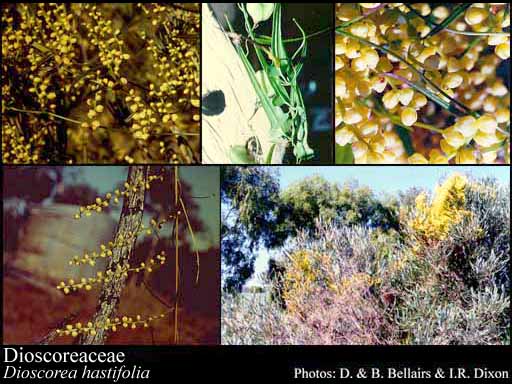- Reference
- Prodr.Fl.Nov.Holland. 294 (1810)
- Name Status
- Current

Scientific Description
Common name. Yam Family.
Habit and leaf form. Shrubs, or herbs, or lianas, or herbaceous climbers. Rhizomatous, or tuberous (the tubers giving rise to annual stems). Climbing (usully), or self supporting (rarely); mostly stem twiners, or scrambling (or trailing). Tamus twining clockwise. Mesophytic, or xerophytic. Leaves alternate (usually), or opposite (rarely); usually spiral; petiolate; sheathing to non-sheathing; simple (usually), or compound; when compound, palmate (with three to six or more leaflets). Leaf blades entire (usually), or dissected (occasionally); when incised, palmately lobed; basically palmately veined; cross-venulate; often cordate, or sagittate. Leaves with stipules, or without stipules. Leaf anatomy. Extra-floral nectaries present (often), or absent. Stem anatomy. Secondary thickening absent, or anomalous; when present, from a single cambial ring. Roots. Roots with velamen (single layered), or without velamen.
Reproductive type, pollination. Fertile flowers hermaphrodite, or functionally male and functionally female, or functionally male, or functionally female. Unisexual flowers present, or absent (rarely). Plants dioecious (usually), or monoecious, or hermaphrodite (Avetra, Stenomeris).
Inflorescence and flower features. Flowers aggregated in ‘inflorescences’; in panicles, in racemes, and in spikes. The terminal inflorescence unit racemose. Inflorescences axillary. Flowers bracteate; bracteolate (one bracteole, rarely two); small (generally inconspicuous); regular; 3 merous. Perigone tube usually present (short). Perianth of ‘tepals’; 6; 2 -whorled; isomerous; joined; sepaloid, or petaloid; similar in the two whorls, or different in the two whorls. Fertile stamens present, or absent (female flowers). Androecium 6 (usually), or 3 (the inner whorl sometimes missing). Androecial members adnate (to the perianth); free of one another, or coherent; when cohering 1 - adelphous (the filaments connate into a tube); 2 -whorled (usually), or 1 -whorled (by reduction). Androecium exclusively of fertile stamens, or including staminodes (the inner whorl sometimes staminodal or obsolete). Staminodes when present, 3. Stamens 6, or 3; isomerous with the perianth, or diplostemonous. Anthers dorsifixed, or adnate; dehiscing via longitudinal slits; extrorse, or introrse; appendaged, or unappendaged. Fertile gynoecium present, or absent (male flowers). Gynoecium 3 carpelled. The pistil 3 celled. Gynoecium syncarpous; synovarious to synstylovarious; inferior. Ovary plurilocular; 3 locular. The ‘odd’ carpel posterior. Gynoecium stylate. Styles 1, or 3; free, or partially joined; apical. Stigmas dry type; non-papillate; Group IV type. Placentation axile. Ovules 2 per locule (usually), or 3–50 per locule (i.e., rarely ‘many’); pendulous; superposed; non-arillate; anatropous.
Fruit and seed features. Fruit fleshy, or non-fleshy; dehiscent, or indehiscent; a capsule (usually), or a berry (Tamus), or a samara (Rajania). Capsules loculicidal. Seeds endospermic. Endosperm oily. Seeds winged (e.g. Dioscorea), or wingless; without starch. Embryo well differentiated (small). Cotyledons 1 (usually, more or less lateral, broad and flat), or 2 (the second rudimentary). Embryo achlorophyllous (1/1). Testa without phytomelan (but with red to yellowish brown phlobaphene). Seedling. Hypocotyl internode present, or absent. Mesocotyl absent. Seedling collar not conspicuous. Cotyledon hyperphyll elongated, or compact; non-assimilatory; dorsiventrally flattened. Coleoptile absent. Seedling cataphylls absent. Primary root ephemeral.
Geography, cytology, number of species. Holarctic, Paleotropical, Neotropical, Cape, Australian, and Antarctic. World distribution: widespread, but mainly tropical. X = 9, 10, 12, 14. 750 species.
Economic uses, etc. Several important food plants, notably yams (Dioscorea).